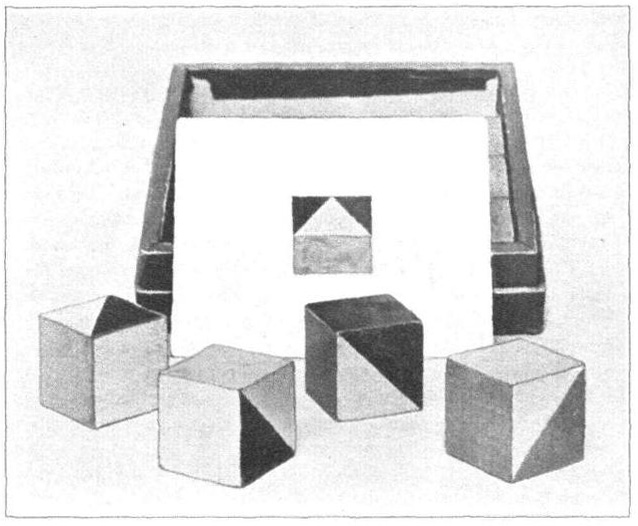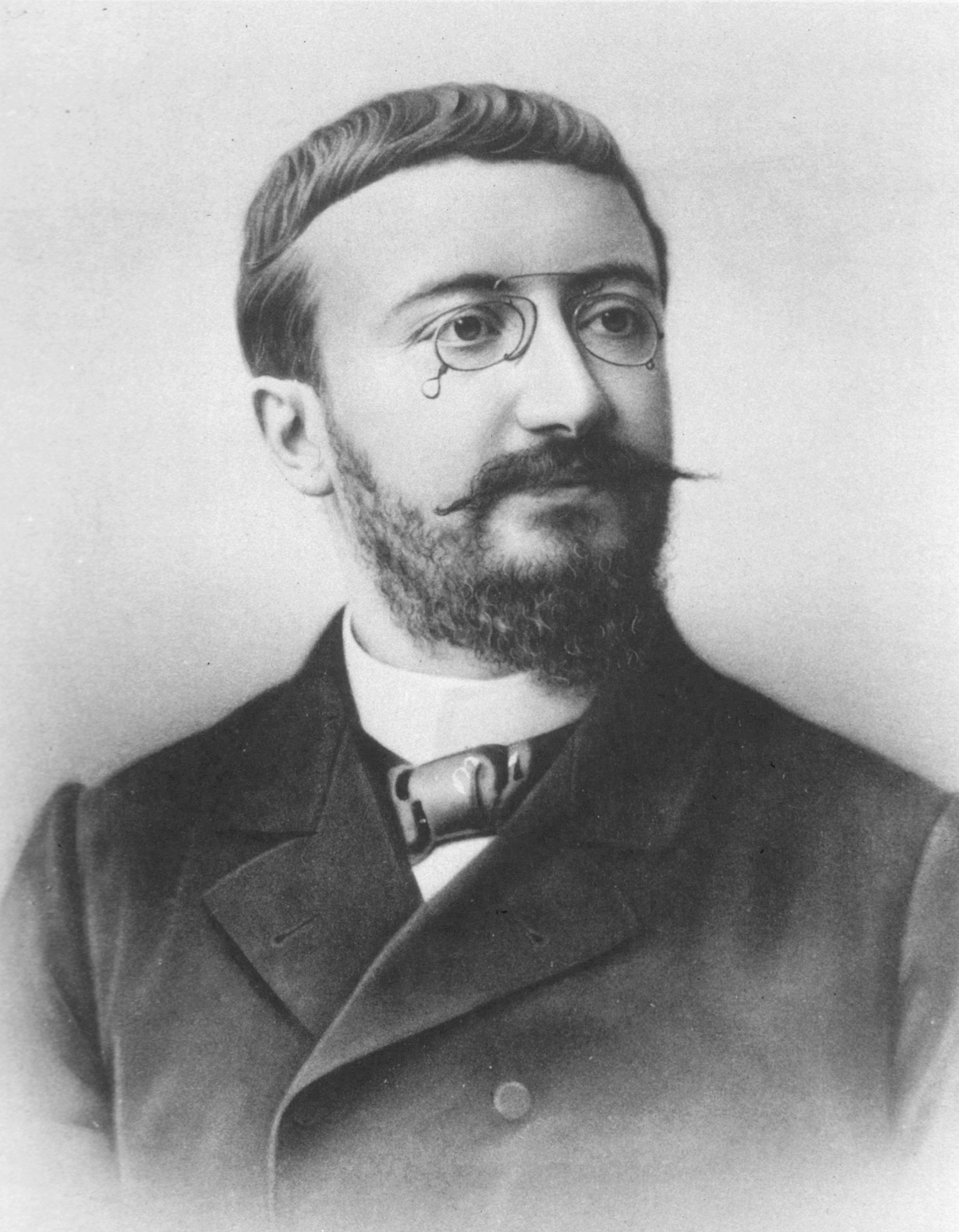|
Kohs Block Design Test
The Kohs Block test, also known as the Kohs Block Design Test, is a performance test designed to be an IQ test. The test taker must, using 16 colored cubes, replicate the patterns displayed on a series of test cards. The design of the test was motivated by a belief that the test could easily be administered to persons with language or hearing disabilities. History The test was developed in 1920 by psychologist Samuel C. Kohs (1890–1984), a student of Lewis Terman, building on earlier and similar designs (such as Francis N. Maxfield's Color Cube Test). Kohs described the 1920s version of the test as a series of 17 cards which increase in complexity as the test progressed. Test takers replicated the designs with painted blocks (each side was a single color or two colors divided by a diagonal line). The initial scores were based on completion time and number of moves. Hutt amended the scoring method to only score completion time. The test was given to both children and adults. A ... [...More Info...] [...Related Items...] OR: [Wikipedia] [Google] [Baidu] |
Kohs Block Design Test - Figure 1
Kohs may refer to: People * Ellis B. Kohs (1916–2000), American composer * Greg Kohs (director), director of AlphaGo AlphaGo is a computer program that plays the board game Go. It was developed by DeepMind Technologies a subsidiary of Google (now Alphabet Inc.). Subsequent versions of AlphaGo became increasingly powerful, including a version that competed u ... * Gregory Kohs, founder of MyWikiBiz * Samuel Calmin Kohs (1890–1984), American psychologist Other * KOHS (radio station), 91.7 FM at Orem High School in Orem, Utah * Keystone Oaks High School, in suburban Pittsburgh, Pennsylvania {{disambig ... [...More Info...] [...Related Items...] OR: [Wikipedia] [Google] [Baidu] |
Intelligence Quotient
An intelligence quotient (IQ) is a total score derived from a set of standardized tests or subtests designed to assess human intelligence. The abbreviation "IQ" was coined by the psychologist William Stern for the German term ''Intelligenzquotient'', his term for a scoring method for intelligence tests at University of Breslau he advocated in a 1912 book. Historically, IQ was a score obtained by dividing a person's mental age score, obtained by administering an intelligence test, by the person's chronological age, both expressed in terms of years and months. The resulting fraction (quotient) was multiplied by 100 to obtain the IQ score. For modern IQ tests, the raw score is transformed to a normal distribution with mean 100 and standard deviation 15. This results in approximately two-thirds of the population scoring between IQ 85 and IQ 115 and about 2.5 percent each above 130 and below 70. Scores from intelligence tests are estimates of intelligence. Unlike, for example, ... [...More Info...] [...Related Items...] OR: [Wikipedia] [Google] [Baidu] |
Cube
In geometry, a cube is a three-dimensional solid object bounded by six square faces, facets or sides, with three meeting at each vertex. Viewed from a corner it is a hexagon and its net is usually depicted as a cross. The cube is the only regular hexahedron and is one of the five Platonic solids. It has 6 faces, 12 edges, and 8 vertices. The cube is also a square parallelepiped, an equilateral cuboid and a right rhombohedron a 3-zonohedron. It is a regular square prism in three orientations, and a trigonal trapezohedron in four orientations. The cube is dual to the octahedron. It has cubical or octahedral symmetry. The cube is the only convex polyhedron whose faces are all squares. Orthogonal projections The ''cube'' has four special orthogonal projections, centered, on a vertex, edges, face and normal to its vertex figure. The first and third correspond to the A2 and B2 Coxeter planes. Spherical tiling The cube can also be represented as a spherical tiling, and ... [...More Info...] [...Related Items...] OR: [Wikipedia] [Google] [Baidu] |
Language
Language is a structured system of communication. The structure of a language is its grammar and the free components are its vocabulary. Languages are the primary means by which humans communicate, and may be conveyed through a variety of methods, including spoken, sign, and written language. Many languages, including the most widely-spoken ones, have writing systems that enable sounds or signs to be recorded for later reactivation. Human language is highly variable between cultures and across time. Human languages have the properties of productivity and displacement, and rely on social convention and learning. Estimates of the number of human languages in the world vary between and . Precise estimates depend on an arbitrary distinction (dichotomy) established between languages and dialects. Natural languages are spoken, signed, or both; however, any language can be encoded into secondary media using auditory, visual, or tactile stimuli – for example, writing, whi ... [...More Info...] [...Related Items...] OR: [Wikipedia] [Google] [Baidu] |
Hearing (sense)
Hearing, or auditory perception, is the ability to perceive sounds through an organ, such as an ear, by detecting vibrations as periodic changes in the pressure of a surrounding medium. The academic field concerned with hearing is auditory science. Sound may be heard through solid, liquid, or gaseous matter. It is one of the traditional five senses. Partial or total inability to hear is called hearing loss. In humans and other vertebrates, hearing is performed primarily by the auditory system: mechanical waves, known as vibrations, are detected by the ear and transduced into nerve impulses that are perceived by the brain (primarily in the temporal lobe). Like touch, audition requires sensitivity to the movement of molecules in the world outside the organism. Both hearing and touch are types of mechanosensation. Hearing mechanism There are three main components of the human auditory system: the outer ear, the middle ear, and the inner ear. Outer ear The outer ear in ... [...More Info...] [...Related Items...] OR: [Wikipedia] [Google] [Baidu] |
Samuel C
Samuel ''Šəmūʾēl'', Tiberian: ''Šămūʾēl''; ar, شموئيل or صموئيل '; el, Σαμουήλ ''Samouḗl''; la, Samūēl is a figure who, in the narratives of the Hebrew Bible, plays a key role in the transition from the biblical judges to the United Kingdom of Israel under Saul, and again in the monarchy's transition from Saul to David. He is venerated as a prophet in Judaism, Christianity, and Islam. In addition to his role in the Hebrew scriptures, Samuel is mentioned in Jewish rabbinical literature, in the Christian New Testament, and in the second chapter of the Quran (although Islamic texts do not mention him by name). He is also treated in the fifth through seventh books of '' Antiquities of the Jews'', written by the Jewish scholar Josephus in the first century. He is first called "the Seer" in 1 Samuel 9:9. Biblical account Family Samuel's mother was Hannah and his father was Elkanah. Elkanah lived at Ramathaim in the district of Zuph. His geneal ... [...More Info...] [...Related Items...] OR: [Wikipedia] [Google] [Baidu] |
Lewis Terman
Lewis Madison Terman (January 15, 1877 – December 21, 1956) was an American psychologist and author. He was noted as a pioneer in educational psychology in the early 20th century at the Stanford Graduate School of Education. He is best known for his revision of the Stanford–Binet Intelligence Scales and for initiating the longitudinal study of children with high IQs called the Genetic Studies of Genius. He was a prominent eugenicist and was a member of the Human Betterment Foundation. He also served as president of the American Psychological Association. A ''Review of General Psychology'' survey, published in 2002, ranked Terman as the 72nd most cited psychologist of the 20th century, in a tie with G. Stanley Hall. Background Terman was born in Johnson County, Indiana, the son of Martha P. (Cutsinger) and James William Terman. He received a BS, BPd (Bachelor of Pedagogy), and BA from Central Normal College in 1894 and 1898, and a BA and MA from the Indiana University B ... [...More Info...] [...Related Items...] OR: [Wikipedia] [Google] [Baidu] |
Ohio School For The Deaf
Ohio () is a state in the Midwestern region of the United States. Of the fifty U.S. states, it is the 34th-largest by area, and with a population of nearly 11.8 million, is the seventh-most populous and tenth-most densely populated. The state's capital and largest city is Columbus, with the Columbus metro area, Greater Cincinnati, and Greater Cleveland being the largest metropolitan areas. Ohio is bordered by Lake Erie to the north, Pennsylvania to the east, West Virginia to the southeast, Kentucky to the southwest, Indiana to the west, and Michigan to the northwest. Ohio is historically known as the "Buckeye State" after its Ohio buckeye trees, and Ohioans are also known as "Buckeyes". Its state flag is the only non-rectangular flag of all the U.S. states. Ohio takes its name from the Ohio River, which in turn originated from the Seneca word ''ohiːyo'', meaning "good river", "great river", or "large creek". The state arose from the lands west of the Appalachian Moun ... [...More Info...] [...Related Items...] OR: [Wikipedia] [Google] [Baidu] |
Block Design Test
A block design test is a subtest on many IQ test batteries used as part of assessment of human intelligence. It is thought to tap spatial visualization ability and motor skill. The test-taker uses hand movements to rearrange blocks that have various color patterns on different sides to match a pattern. The items in a block design test can be scored both by accuracy in matching the pattern and by speed in completing each item. Historical background David Wechsler adapted a block design subtest for his Wechsler-Bellevue test, the predecessor of his WAIS (Wechsler Adult Intelligence Scale), from the Kohs block design test developed in 1920 at Stanford University by Samuel Calmin Kohs. A later revision of the Kohs test by Hutt incorporated the time taken to complete each item into the scoring of the test. Wechsler followed that practice in making both accuracy and speed factors in scoring the test. Neuropsychological assessment Good performance on the block design test is indicat ... [...More Info...] [...Related Items...] OR: [Wikipedia] [Google] [Baidu] |






